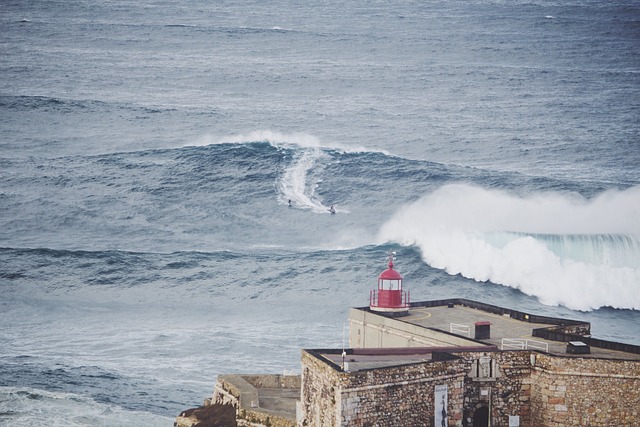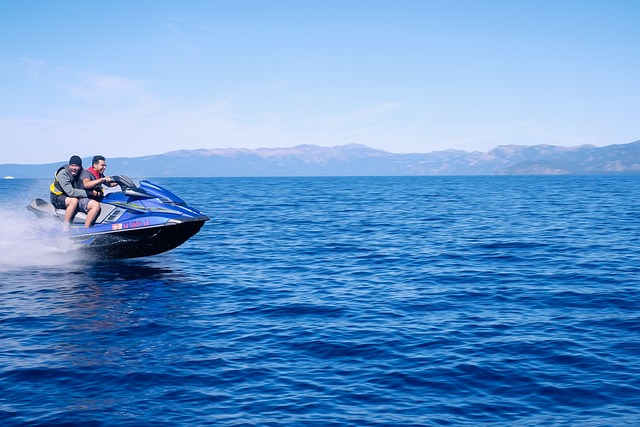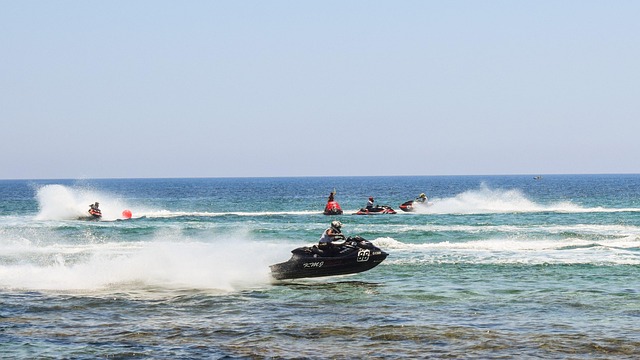Offshore jet ski racing (JBR) captivates enthusiasts with its thrilling action on open waters, featuring athletes navigating challenging courses in intense waves and currents using specialized high-performance Jet Ski JBR models. This sport demands advanced handling techniques and strategic thinking, with participants competing for speed through a series of buoys. The JBR's cutting-edge technology, including powerful engines and hydrofoil systems, enhances performance while strict safety regulations ensure secure racing conditions. Mastering strategies like hydroplaning, course selection, and timing is crucial for victory in this exhilarating Jet Ski Battle Royale (JBR) competition.
“Unleash the speed and thrill of Offshore Racing JBR, where powerful jet skis push the boundaries of watercraft performance. This article provides a comprehensive guide to understanding this exhilarating sport. From the technological advancements that drive JBR jets to the crucial safety measures and training techniques, we explore what makes these races both challenging and captivating. Discover the key components, strategies, and regulations that define the world of Offshore Racing JBR and gain insights into why it’s more than just a race—it’s an engineering marvel on waves.”
- Understanding Offshore Racing JBR: An Overview
- The Evolution of Jet Ski Technology for Racing
- Key Components and Design Features of JBR Jets
- Training and Preparation for Offshore Racing Challenges
- Navigating Safety Measures and Regulations in JBR Races
- Top Strategies for Optimizing Performance in JBR Competitions
Understanding Offshore Racing JBR: An Overview

Offshore racing JBR, a thrilling and specialized category within the jet ski world, captivates enthusiasts with its high-speed adventures on open waters. This unique form of competition pushes the boundaries of jet ski performance, showcasing the raw power and agility of these machines. At its core, JBR involves athletes navigating challenging offshore courses, often featuring intense waves, currents, and diverse marine environments.
The Jet Ski (JBR) racing experience is a true test of skill, courage, and machine prowess. Participants navigate through a series of buoys or marked turns, with the fastest completion time taking top honors. These races demand advanced handling techniques, precision maneuvering, and an intimate understanding of jet ski dynamics in varying water conditions. With specialized craft designed for offshore performance, JBR offers an exhilarating platform for both competitors and spectators alike to embrace the thrill of high-seas racing.
The Evolution of Jet Ski Technology for Racing

The world of offshore racing has witnessed a remarkable evolution in jet ski technology, especially with the emergence of the powerful and innovative Jet Ski JBR models. Over the years, these watercraft have transformed from simple personal watercraft to high-performance machines capable of reaching incredible speeds. The initial jet skis were relatively basic, designed for leisure and recreational purposes, but as racing gained popularity, manufacturers focused on enhancing speed, maneuverability, and stability.
This shift towards competition led to significant advancements in engine technology, with a move from two-stroke to four-stroke engines, offering better control and efficiency. The Jet Ski JBR series has taken this further, incorporating advanced hydrofoil systems that reduce drag, allowing for higher top speeds and improved fuel efficiency. These technological leaps have not only raised the bar for racing performance but have also inspired innovations that benefit everyday jet ski enthusiasts, ensuring a continuous cycle of improvement in the sport.
Key Components and Design Features of JBR Jets

The Jet Ski JBR, a marvel in offshore racing, boasts several key components and design features that set it apart. At its heart lies a powerful engine, meticulously engineered to deliver unparalleled speed and agility on open waters. These jet skis are equipped with advanced hydrofoil systems, allowing them to glide smoothly over the waves, providing both efficiency and stability at high speeds. The sleek and aerodynamic body design is crucial for cutting through water, minimizing drag, and maximizing performance.
Additionally, JBR jets incorporate sophisticated navigation and safety systems. Advanced GPS and radar technologies enable precise tracking and course navigation, while state-of-the-art communication devices ensure seamless contact during races. Safety features such as robust composite materials, powerful brakes, and advanced impact protection further enhance the rider’s experience, making these jet skis not just high-performance machines but also reliable and secure for offshore racing enthusiasts.
Training and Preparation for Offshore Racing Challenges

Offshore racing, particularly on jet skis like the JBR, demands rigorous training and preparation to overcome the unique challenges posed by open water. Athletes must adapt to unpredictable conditions including waves, currents, and varying weather patterns. This involves honing not just their physical skills but also strategic thinking and mental resilience. Specialized training programs focus on building endurance, refining handling techniques, and mastering navigation skills in diverse marine environments.
Pre-race preparation includes meticulous equipment checks to ensure the jet ski is in optimal condition for high-speed racing. Athletes also employ visualization techniques, mentally rehearsing the course and potential obstacles. Moreover, they maintain a strict fitness regimen to enhance agility, strength, and cardiovascular health, crucial for enduring the demanding physical demands of offshore racing competitions on a jet ski JBR.
Navigating Safety Measures and Regulations in JBR Races

Navigating safety is a paramount concern in offshore racing, especially for high-speed events like Jet Ski JBR competitions. Participants engage with stringent regulations designed to safeguard riders and ensure fair play. These include mandatory safety gear, such as personal flotation devices (PFDs) and helmet configurations approved for impact protection. The jet skis themselves undergo rigorous inspections to meet safety standards, ensuring they’re equipped with the right technology for monitoring engine performance and rider well-being.
Regulations also govern course setup and marking, water conditions, and even weather parameters to prevent hazards. Race organizers collaborate with maritime authorities to ensure compliance, fostering an environment where both riders and officials can focus on the thrill of competition without compromising safety. This commitment to regulation adherence underscores the dedication to making JBR races not just exhilarating but also secure for all participants.
Top Strategies for Optimizing Performance in JBR Competitions

In the fast-paced world of offshore racing JBR (Jet Ski Battle Royale), optimizing performance is key to claiming victory. Athletes and teams employing top strategies can gain a significant edge over their competitors. One of the most effective tactics is mastering the art of hydroplaning, allowing jet skiers to achieve incredible speeds by minimizing contact with the water surface. This technique requires precise handling and timing to maintain stability while leveraging the reduced drag.
Additionally, strategic course selection and navigation play a vital role in JBR competitions. Jet ski jbr participants should look for routes that offer smoother waters and fewer obstacles, ensuring optimal speed and agility. Timing is crucial; starting positions matter, and a well-timed maneuver can shift dynamics, giving a racer an advantage. Effective communication among team members is also essential for coordinated strategies during the race, making every second count towards crossing the finish line first.
Offshore racing JBR, or Jet Ski Boosted Racing, is a thrilling and technologically advanced sport that pushes the limits of jet ski performance. By understanding the evolution of jet ski technology, mastering key components, and adhering to safety regulations, competitors can optimize their strategies and experience the exhilarating rush of cutting-edge watercraft racing. The combination of powerful engines, innovative design features, and rigorous training prepares athletes for the unique challenges of JBR, ensuring a dynamic and competitive environment for all participants.
